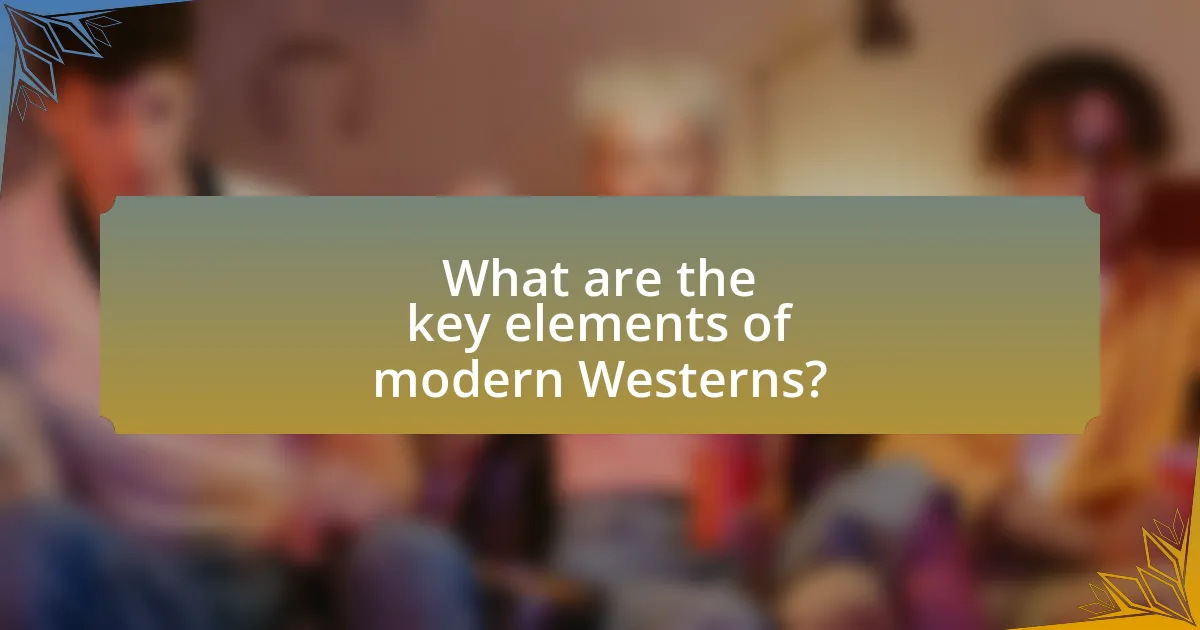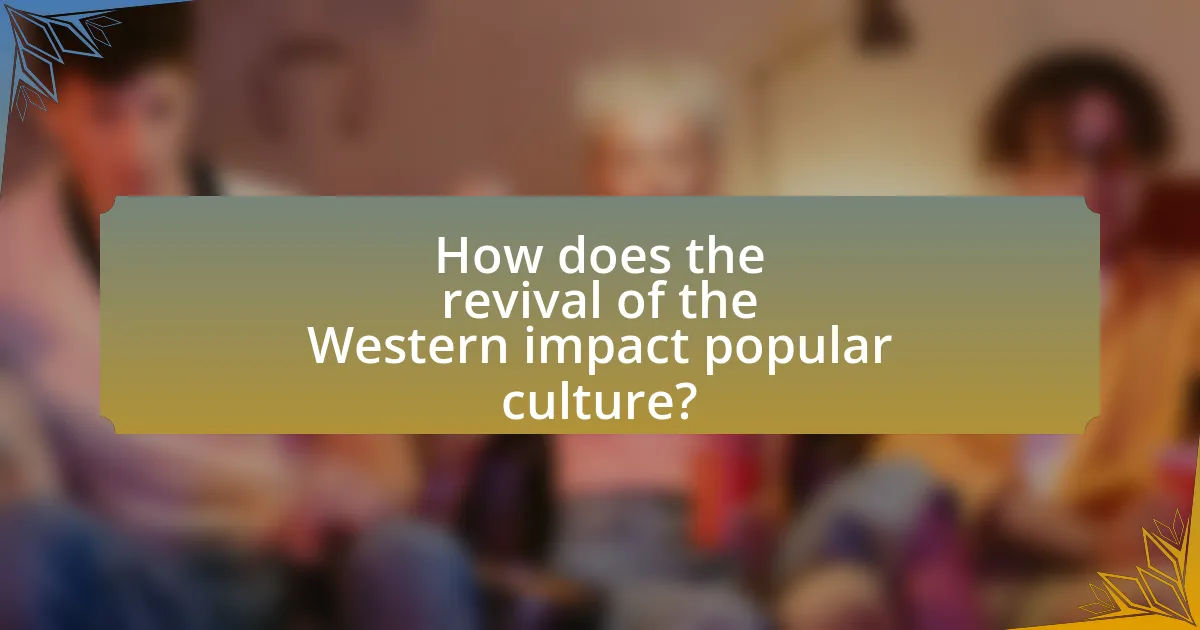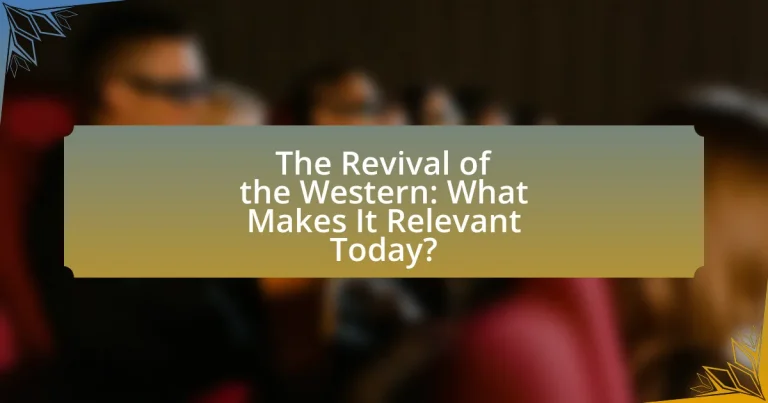The article examines the revival of the Western genre in film and television, highlighting its resurgence through contemporary productions that reinterpret classic themes of frontier life, lawlessness, and individualism. It discusses the evolution of the genre from simplistic portrayals to complex narratives that address modern social issues such as race, gender, and morality. Key recent works like “The Harder They Fall” and “Westworld” are analyzed for their innovative storytelling and cultural relevance, while the article also explores the historical decline of the Western and the factors contributing to its renewed popularity. Additionally, it addresses how contemporary Westerns reflect societal dynamics and the changing portrayal of characters, particularly women, within the genre.

What is the Revival of the Western?
The Revival of the Western refers to the resurgence of interest in Western genre films and television shows, characterized by their themes of frontier life, lawlessness, and individualism. This revival has been marked by contemporary productions that reinterpret classic Western tropes, such as “Westworld” and “The Harder They Fall,” which have garnered critical acclaim and audience engagement. The relevance of this revival is underscored by its exploration of modern social issues, such as race, gender, and morality, reflecting current societal dynamics while paying homage to the genre’s historical roots.
How has the Western genre evolved over time?
The Western genre has evolved from its early 20th-century roots, characterized by simplistic portrayals of cowboys and outlaws, to a more complex and nuanced representation in contemporary media. Initially, Westerns focused on clear moral dichotomies and heroic figures, as seen in films like “Stagecoach” (1939) and “Shane” (1953). Over time, the genre began to incorporate themes of realism, social issues, and character depth, exemplified by works such as “Unforgiven” (1992) and “Deadwood” (2004), which challenged traditional narratives and explored the darker aspects of frontier life. This evolution reflects broader societal changes and a shift in audience expectations, leading to a revival of the Western that resonates with modern themes of identity, morality, and justice.
What historical factors contributed to the decline of the Western genre?
The decline of the Western genre can be attributed to several historical factors, including changing societal values, the rise of new film genres, and shifts in audience preferences. As American society evolved during the late 1960s and 1970s, themes of individualism and rugged masculinity prevalent in Westerns began to clash with emerging countercultural movements that emphasized diversity and social justice. Additionally, the popularity of genres such as science fiction and action films, which offered more contemporary and relatable narratives, drew audiences away from traditional Westerns. The introduction of anti-hero characters and complex storytelling in films like “The Godfather” and “Easy Rider” further shifted audience expectations, leading to a decline in the Western’s appeal. These factors collectively contributed to the genre’s diminished prominence in American cinema.
What recent films or series signify the revival of the Western?
Recent films and series that signify the revival of the Western include “The Harder They Fall,” “Old Henry,” and the series “1883.” “The Harder They Fall,” released in 2021, reimagines the Western genre with an all-Black cast and a modern narrative style, showcasing the genre’s adaptability. “Old Henry,” also from 2021, presents a traditional Western story with a focus on character depth and moral complexity, appealing to classic Western fans. The series “1883,” a prequel to “Yellowstone,” explores the American frontier’s challenges and has garnered significant viewership, indicating renewed interest in Western themes. These works collectively highlight the Western’s relevance and evolution in contemporary storytelling.
Why is the Western genre experiencing a resurgence today?
The Western genre is experiencing a resurgence today due to a combination of nostalgia, cultural reflection, and innovative storytelling. This revival is fueled by audiences seeking familiar themes of heroism, morality, and the struggle for justice, which resonate in contemporary societal issues. Recent successful films and series, such as “Yellowstone” and “The Harder They Fall,” have demonstrated that modern interpretations can attract diverse viewers while maintaining the genre’s core elements. Additionally, the rise of streaming platforms has provided more opportunities for creators to explore and reinvent Western narratives, making the genre more accessible and relevant to today’s audiences.
What cultural shifts are influencing the revival of the Western?
The revival of the Western genre is influenced by cultural shifts such as the re-examination of historical narratives, increased interest in diverse storytelling, and a growing desire for escapism in contemporary media. The re-examination of historical narratives allows for a more nuanced portrayal of the American West, challenging traditional stereotypes and highlighting marginalized voices. This shift is evident in films and series that incorporate perspectives from Indigenous peoples and women, reflecting a broader societal push for inclusivity. Additionally, the rise of streaming platforms has facilitated access to a wider range of Westerns, allowing for innovative interpretations that resonate with modern audiences. The desire for escapism, particularly during times of social and political unrest, has also led to a resurgence in interest in the Western, as viewers seek narratives that transport them to different times and places.
How do contemporary themes resonate with traditional Western narratives?
Contemporary themes resonate with traditional Western narratives by reflecting modern societal issues such as identity, morality, and justice within the framework of classic Western tropes. For instance, contemporary Westerns often explore themes of racial and gender equality, as seen in films like “The Harder They Fall,” which reimagines the genre by featuring a predominantly Black cast and addressing historical injustices. This approach not only honors the genre’s roots but also critiques and expands upon its narratives, making them relevant to today’s audiences. Additionally, the incorporation of complex characters who grapple with ethical dilemmas mirrors the internal conflicts faced by figures in traditional Westerns, thereby bridging the gap between past and present storytelling.

What are the key elements of modern Westerns?
The key elements of modern Westerns include complex characters, moral ambiguity, and contemporary themes that reflect current societal issues. Modern Westerns often feature protagonists who grapple with personal dilemmas and ethical conflicts, moving away from the traditional hero archetype. Additionally, these films frequently address themes such as justice, identity, and the impact of technology on society, showcasing a blend of classic Western motifs with modern storytelling techniques. For instance, films like “No Country for Old Men” and “Hell or High Water” exemplify this shift by incorporating elements of crime and social commentary, thus making the genre relevant to contemporary audiences.
How do character archetypes in modern Westerns differ from classic ones?
Character archetypes in modern Westerns differ from classic ones primarily through their complexity and moral ambiguity. Classic Westerns typically featured clear-cut heroes and villains, such as the noble cowboy and the ruthless outlaw, reflecting a binary moral framework. In contrast, modern Westerns often present protagonists with flawed characteristics and ambiguous motivations, showcasing a more nuanced exploration of morality. For example, films like “No Country for Old Men” and “The Assassination of Jesse James by the Coward Robert Ford” illustrate characters who grapple with internal conflicts and societal issues, moving beyond the simplistic archetypes of the past. This shift reflects broader cultural changes and a desire for deeper storytelling in contemporary cinema.
What roles do protagonists and antagonists play in contemporary Westerns?
Protagonists in contemporary Westerns often embody complex moral codes and personal struggles, reflecting modern societal issues, while antagonists typically represent external threats or societal injustices that challenge these protagonists. For instance, films like “No Country for Old Men” illustrate protagonists grappling with violence and morality, while the antagonists symbolize the chaos and moral ambiguity of contemporary life. This dynamic serves to engage audiences by highlighting the internal and external conflicts that resonate with current themes of justice, identity, and survival in a rapidly changing world.
How is the portrayal of women evolving in the Western genre?
The portrayal of women in the Western genre is evolving from traditional, often one-dimensional roles to more complex and empowered characters. Historically, women in Westerns were frequently depicted as damsels in distress or secondary figures, but contemporary narratives are increasingly showcasing female protagonists who possess agency, strength, and depth. For example, films like “The Homesman” and “Meek’s Cutoff” present women as resilient and resourceful, challenging the male-dominated landscape of the genre. This shift reflects broader societal changes regarding gender roles and highlights the importance of diverse storytelling in modern cinema.
What themes are prevalent in today’s Westerns?
Prevalent themes in today’s Westerns include the exploration of morality, the clash between civilization and wilderness, and the complexities of identity and belonging. Modern Westerns often depict characters grappling with ethical dilemmas, reflecting contemporary societal issues such as justice and redemption. The tension between the encroachment of modernity and the rugged individualism of the frontier is frequently highlighted, showcasing the struggle to maintain traditional values in a changing world. Additionally, themes of racial and cultural diversity are increasingly represented, addressing historical injustices and the multifaceted nature of the American experience. These themes resonate with audiences by connecting the genre’s historical roots to current social dynamics.
How do modern Westerns address issues of morality and justice?
Modern Westerns address issues of morality and justice by exploring complex characters and ambiguous ethical dilemmas that challenge traditional notions of right and wrong. Films like “No Country for Old Men” and “Hell or High Water” depict protagonists who operate outside the law, forcing audiences to grapple with the consequences of their actions and the societal structures that shape their choices. These narratives often highlight the failures of justice systems, as seen in “The Assassination of Jesse James by the Coward Robert Ford,” where the pursuit of vengeance complicates moral clarity. By presenting morally gray situations, modern Westerns invite viewers to reflect on the nature of justice and the human condition, making them relevant in contemporary discussions about ethics and societal values.
What social issues are reflected in the narratives of contemporary Westerns?
Contemporary Westerns reflect social issues such as racial inequality, gender dynamics, and environmental concerns. These narratives often depict the struggles of marginalized communities, highlighting the historical injustices faced by Native Americans and people of color, as seen in films like “The Harder They Fall,” which reimagines the Western genre with a predominantly Black cast. Gender dynamics are explored through strong female characters who challenge traditional roles, as exemplified in “The Ballad of Buster Scruggs,” where women assert agency in a male-dominated landscape. Additionally, contemporary Westerns address environmental issues, portraying the impact of industrialization and land exploitation, as illustrated in “Hell or High Water,” which critiques economic disparity and the consequences of resource depletion.

How does the revival of the Western impact popular culture?
The revival of the Western genre significantly impacts popular culture by reintroducing themes of individualism, morality, and frontier justice, which resonate with contemporary societal issues. This resurgence is evident in films and television series that reinterpret classic Western narratives, such as “Westworld” and “The Harder They Fall,” which incorporate modern storytelling techniques and diverse casts. These adaptations not only attract new audiences but also provoke discussions about race, gender, and identity, reflecting current cultural dialogues. The Western’s revival thus serves as a lens through which popular culture examines and critiques modern values and conflicts, reinforcing its relevance in today’s media landscape.
What influence do modern Westerns have on other film genres?
Modern Westerns significantly influence other film genres by incorporating themes of morality, anti-heroism, and rugged individualism, which resonate across various storytelling formats. For instance, the narrative structures and character archetypes found in modern Westerns, such as the lone protagonist facing moral dilemmas, have been adopted in genres like action, thriller, and even science fiction, as seen in films like “Logan” and “The Mandalorian.” These films utilize Western motifs to explore complex human emotions and societal issues, demonstrating the versatility and relevance of Western themes in contemporary cinema. The blending of Western elements with other genres not only revitalizes the Western itself but also enriches the storytelling landscape, making it a foundational influence in modern filmmaking.
How are Western tropes being integrated into non-Western films?
Western tropes are being integrated into non-Western films through the adaptation of narrative structures, character archetypes, and thematic elements commonly found in Western cinema. For instance, films from countries like India and South Korea often incorporate the lone hero, moral dilemmas, and the battle between good and evil, which are hallmark traits of Westerns. A notable example is the Indian film “Lagaan,” which mirrors the Western trope of an underdog facing oppression, showcasing a community’s struggle against a powerful adversary. This integration reflects a blending of cultural storytelling techniques, allowing non-Western filmmakers to resonate with global audiences while maintaining local relevance.
What role does nostalgia play in the popularity of the Western genre?
Nostalgia significantly enhances the popularity of the Western genre by evoking a longing for a simpler, more heroic past. This emotional connection draws audiences to classic themes of adventure, morality, and rugged individualism that characterized early Western films. The genre’s revival can be attributed to its ability to transport viewers to an idealized version of American history, often romanticizing the frontier experience. Studies indicate that nostalgia can increase viewer engagement and satisfaction, as seen in the resurgence of Western-themed media, which often incorporates modern storytelling techniques while retaining traditional elements. This blend appeals to both older audiences who remember the genre’s heyday and younger viewers discovering it anew, thus solidifying its relevance in contemporary culture.
What can audiences expect from the future of the Western genre?
Audiences can expect a revitalization of the Western genre that incorporates contemporary themes and diverse perspectives. This evolution is evident in recent films and series that blend traditional Western elements with modern storytelling techniques, addressing issues such as social justice, identity, and environmental concerns. For instance, productions like “The Harder They Fall” and “Godless” showcase a more inclusive representation of characters and narratives, reflecting current societal dynamics. As the genre adapts, it is likely to attract a broader audience while maintaining its classic appeal, ensuring its relevance in today’s cinematic landscape.
How might emerging filmmakers shape the next wave of Westerns?
Emerging filmmakers might shape the next wave of Westerns by infusing contemporary themes and diverse perspectives into the genre. This shift can be seen in recent films that challenge traditional narratives, such as “The Harder They Fall,” which features a predominantly Black cast and addresses issues of race and identity within a Western context. By incorporating modern social issues, these filmmakers can attract a broader audience and redefine the genre’s relevance. Additionally, the use of innovative storytelling techniques and technology, such as virtual reality and interactive narratives, can further engage viewers and create a fresh cinematic experience.
What trends are likely to define the future of Western storytelling?
The future of Western storytelling is likely to be defined by increased diversity in narratives, a focus on complex characters, and the integration of modern themes such as social justice and environmentalism. As audiences demand more representation, stories will incorporate perspectives from various cultural backgrounds, moving beyond traditional archetypes. This shift is evidenced by recent films and series that blend Western elements with contemporary issues, appealing to a broader audience. For instance, the success of projects like “The Harder They Fall” showcases how reimagining the genre with diverse casts and narratives resonates with viewers, indicating a significant trend in the evolution of Western storytelling.
What are some recommendations for exploring the revival of the Western?
To explore the revival of the Western, engage with contemporary films and series that reinterpret classic themes, such as “The Harder They Fall” and “Westworld.” These works highlight modern societal issues while maintaining traditional Western elements. Additionally, analyze critical essays and reviews that discuss the genre’s evolution, such as those found in film journals like “Cinefex” or “Film Quarterly,” which provide insights into how the Western reflects current cultural narratives. Attending film festivals that showcase new Westerns can also offer firsthand experience of the genre’s revival and its relevance today.


